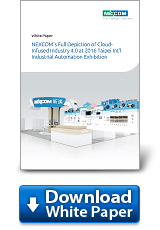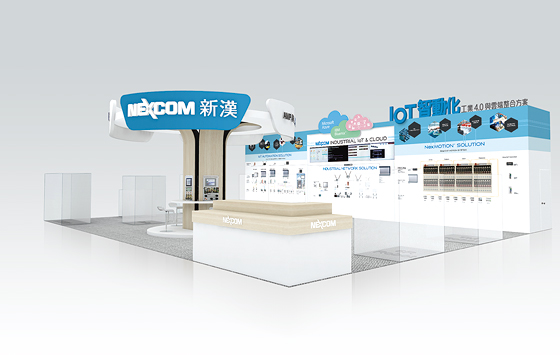NEXCOM's Full Depiction of Cloud-Infused Industry 4.0 at 2016 Taipei Int'l Industrial Automation Exhibition
 Putting Industry 4.0 into practice has become a universal lesson throughout the industry. However, most Industry 4.0 interpretations in recent years have mainly focused on the data side of things. To extend beyond the focus, this year at the 2016 Taipei International Industrial Automation Exhibition, NEXCOM will demonstrate how it harnesses the technology of edge to cloud connectivity, cloud-based machine learning and cognitive computing to tap into the power of big data analytics to improve factory operations.
Putting Industry 4.0 into practice has become a universal lesson throughout the industry. However, most Industry 4.0 interpretations in recent years have mainly focused on the data side of things. To extend beyond the focus, this year at the 2016 Taipei International Industrial Automation Exhibition, NEXCOM will demonstrate how it harnesses the technology of edge to cloud connectivity, cloud-based machine learning and cognitive computing to tap into the power of big data analytics to improve factory operations.
The first step to take for Industry 4.0 transformation is to establish connectivity between all the devices and equipment in a factory, and then integrate cloud computing, big data analytics and artificial intelligence to create cyber-physical systems for building a smart factory. On the surface, Industry 4.0 may seem simple, but the underlying transformation must take various variables into account, such as robots, motion control systems, device connectivity and communication protocols. Bringing these elements together to begin with is no easy task, and figuring out how to apply and translate cloud-based big data analytics into concrete, actionable solutions to optimize operations can prove to be more difficult later on.
Due to the scope of Industry 4.0, it is rare to see an application demonstration of Industry 4.0 and cloud computing in full context at exhibitions. However, NEXCOM will be the first to showcase a complete cloud-based Industry 4.0 solution built from the ground up at the 2016 Taipei International Industrial Automation Exhibition.

First Ever Complete Edge to Cloud Demonstration for Industry 4.0
Joe Lin, General Manager of NEXCOM’s IoT Automation Solutions Business Group, states, "In 2016, Industry 4.0 has grown out of its 'exploration' phase and reached 'pilot' phase. It is no longer a concept, but an executable action. Hence, NEXCOM's exhibition this year will focus on 'Industry 4.0 implementation'. At the show, NEXCOM will showcase NexROBO, NexMotion, iAutomation and Device Networking product lines in action, demonstrating how they come together and integrate with Microsoft Azure platform as a complete solution. In addition, NEXCOM will display its Industrial IoT Studio software and show how it manages the connection between field devices and the cloud, and nCare remote management tool to show how it consolidates management of wireless networks and associated wireless client devices."
Lin points out that to allow exhibition visitors quickly grasp the wonders of Industry 4.0, NEXCOM will prepare a user experience zone featuring hands-on instructions of the NexROBO simulation software, iAutomation CPS control system, Industrial IoT Studio, machine vision development tool and ToGazer video conferencing software. Visitors will experience how NEXCOM's cloud-based Industry 4.0 solution will speed the development and coding of robot control, PLC and HMI systems, including the application development for cloud-based services and AOI programs to enable visitors to instantly verify end results.
Furthermore, NEXCOM will showcase a real-life application of Industry 4.0 on four displays in collaboration with Googol Technology as part of the Advanced Manufacturing Partnership (AMP). Each display will feature a different area of focus, all adding up to paint a complete picture of Industry 4.0.
First, 5-axis milling machines, dual-drive gantry control and robot control development will be displayed to portray operations of a smart factory. Second, collaborative 6-axis articulated robots, image control systems and Delta robots will be shown to depict robot arm movements. Third, NEXCOM's Industrial IoT Gateways will be on display to collect and transfer field equipment data to Microsoft Azure platform to demonstrate real-time monitoring of operations. Lastly, the data will then be processed through Microsoft Azure Machine Learning to showcase predictive analytics.
Uniting Collaborative Forces of AMP to Strengthen Industry 4.0 Services
The integration of NEXCOM's Industrial IoT Gateways with Microsoft Azure will be achieved using the web service of Azure IoT Hub (MQTT service). Azure Stream Analytics will also be employed to sort and archive field data to designated databases. Next, Microsoft Azure Machine Learning Services and Cortana Cognitive Services will be used to run data analytics and identify whether the functional status of field devices is above normal threshold. When the value rises above the threshold, alert messages will be sent as notifications and control commands will be issued to halt operation of the abnormal device.
Lin further points out that in addition to the user experience zone and real-life Industry 4.0 application, an expert commentary session will be held every morning during the exhibition period. The commentary aims to help visitors gain an understanding of how bridging the communication from the edge to cloud and applying cloud-based services and cognitive computing can bring tremendous business value. NEXCOM has collaborated with a Japanese partner to develop a large-scale gateway project for energy monitoring, which can potentially help a large convenience-store chain save millions of dollars in utilities costs. This further reinforces the IIoT transition to the 'pilot' phase.
Also, NEXCOM has built a portfolio of AMP collaborations consisting of fifteen partners throughout Taiwan and China. These partners not only include robot developers, but also system integrators in various vertical markets such as consumer electronics, paper, food processing and petrochemical. In the future, NEXCOM will work closely with partners and jointly develop cloud-based Industry 4.0 solutions. Lin expresses great honor to welcome visitors to NEXCOM at the 2016 Taipei International Industrial Automation Exhibition, whether it is developers of robot bodies, system integration experts from different verticals, manufacturers of servo motor, I/O and AOI components, or even research and academic organizations, come visit NEXCOM to explore the opportunity of partnership.
- Related Links:
- Physical AI Hits the Factory Floor: Predictive Optimization for Chemical Processes
- Step into the Future of Cybersecurity AI with NEXCOM at GITEX, Dubai
- Browse Other News:
- NEXCOM’s HPPC Series: High-Brightness Panel PCs Built for Industrial Reliability
- The NDiS B562: Powering Precision in Edge AI and AOI Applications
- All White Papers News
